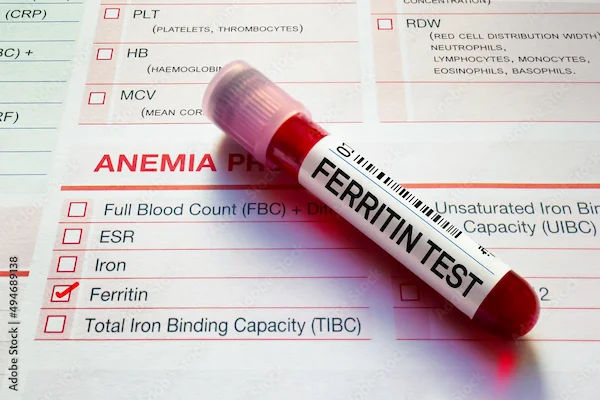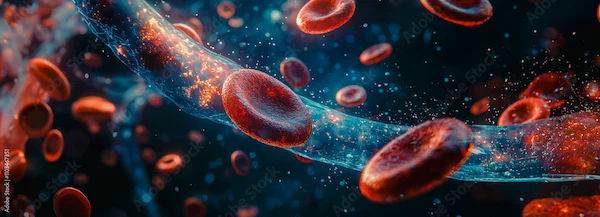Anaemia: Types, Symptoms, Causes
Learn about anaemia, including its types, symptoms, and causes. Understand how this blood disorder affects your health and discover potential treatments and preventive measures.

Written by Dr.Sonia Bhatt
Last updated on 3rd Jul, 2025

Introduction
Anaemia is a blood disorder that occurs when you have a lower than normal number of red blood cells or when your red blood cells do not function properly. These cells are responsible for carrying oxygen throughout your body, so when they are lacking or impaired, your organs and tissues may not receive the oxygen they need. While some forms of anaemia are inherited, others can develop during a person's life due to various conditions. Depending on the type, anaemia can range from mild and easily treated to severe and potentially life-threatening. In this article, we will explore the various types, symptoms, causes, and treatment options for anaemia.
Types of Anaemia
Anaemia can be broadly classified into several categories, which may either develop during a person’s lifetime (acquired) or be present from birth (inherited). Each type has its causes and characteristics:
1.Acquired Anaemia: This type of anaemia develops during a person's life, often as a result of disease, poor nutrition, or another medical condition:
Anaemia of chronic disease: Typically caused by chronic inflammation that hinders the body's ability to use iron for red blood cell production.
Autoimmune haemolytic anaemia: Occurs when the body’s immune system mistakenly attacks and destroys its own red blood cells.
Macrocytic and megaloblastic anaemia: When the bone marrow produces unusually large red blood cells, often due to deficiencies in vitamin B12 or folate.
Normocytic anaemia: Characterised by normal-sized red blood cells, but in lower numbers.
Pernicious anaemia: An autoimmune condition that prevents the absorption of vitamin B12, leading to a deficiency.
2.Inherited Anaemia: These forms are present from birth and often have genetic origins:
Diamond-Blackfan anaemia: A rare disorder where the bone marrow fails to produce enough red blood cells.
Fanconi anaemia: A rare genetic disorder that increases the risk of developing anaemia and other blood conditions.
Sickle cell anaemia: Red blood cells become misshapen, leading to blockages in blood flow and oxygen delivery.
Thalassaemia: A genetic disorder that causes insufficient production of haemoglobin, resulting in smaller red blood cells and anaemia.
3.Other Types of Anaemia: Some types of anaemia can either be inherited or acquired:
Aplastic anaemia: A condition where the bone marrow does not produce enough blood cells.
Haemolytic anaemia: Characterised by the rapid breakdown of red blood cells.
Microcytic anaemia: Results from small red blood cells due to insufficient haemoglobin, often caused by iron deficiency.
Sideroblastic anaemia: Caused by problems with iron use during red blood cell development.
Common Symptoms of Anaemia
The symptoms of anaemia can vary depending on the underlying cause and its severity. In some cases, the symptoms may be mild and may only become noticeable as the condition worsens. Some of the most common signs of anaemia include:
Tiredness and general fatigue
Weakness and low energy
Shortness of breath, especially during physical activity
Pale or yellowish skin, often more noticeable on lighter skin tones
Irregular heartbeat (palpitations)
Dizziness or feeling lightheaded
Chest pain, particularly in severe cases
Cold hands and feet
Headaches and difficulty concentrating
Causes of Anaemia
Anaemia occurs when there is insufficient haemoglobin or red blood cells in the bloodstream. Several factors can lead to this condition:
Inadequate production of red blood cells: The body may not produce enough red blood cells due to nutritional deficiencies, bone marrow problems, or chronic disease.
Excessive blood loss: This could be due to heavy menstrual periods, surgery, trauma, or gastrointestinal bleeding.
Destruction of red blood cells: Conditions such as haemolytic anaemia cause the body to destroy red blood cells faster than it can replace them.
Risk Factors for Anaemia
Several factors can increase your risk of developing anaemia:
Diet: Insufficient intake of iron, vitamin B12, and folate can significantly increase the risk of anaemia.
Intestinal issues: Conditions that affect nutrient absorption, such as Crohn's disease or coeliac disease, can lead to anaemia.
Menstrual periods: Heavy menstrual bleeding increases the risk of iron-deficiency anaemia.
Pregnancy: Pregnant women who do not take supplements with folic acid and iron may develop anaemia.
Chronic conditions: Diseases like cancer, kidney disease, and diabetes can lead to anaemia of chronic disease.
Chronic blood loss: Conditions like ulcers or internal bleeding can deplete iron stores, leading to anaemia.
Family history: Inherited anaemias, such as sickle cell anaemia, increase the risk of developing these types.
Age: People over the age of 65 may have a higher risk of developing anaemia.
Diagnosis of Anaemia
To diagnose anaemia, your healthcare provider will perform various tests:
Complete Blood Count (CBC): This test helps assess the overall health of your blood, including the number, size, and shape of red blood cells.
Haemoglobin Test: Measures the haemoglobin in your blood, helping to detect anaemia.
Hematocrit Test: Determines the percentage of red blood cells in your blood.
Peripheral Blood Smear: A blood sample is examined under a microscope to evaluate the size and shape of red blood cells.
Reticulocyte Count: This test measures the number of immature red blood cells in circulation, indicating bone marrow function.
Get Tested for Dengue
Treatment Options for Anaemia
Treatment for anaemia depends on its cause. In many cases, the condition can be managed through dietary changes, supplements, and medications.
1. Dietary Changes and Supplements
The dietary changes and supplements include:
Iron supplements: Often prescribed for those with iron-deficiency anaemia. Available as tablets or capsules, iron helps the body produce red blood cells.
Folic acid supplements: Important for the production of red blood cells and DNA. A folate deficiency can lead to megaloblastic anaemia.
Vitamin B12 supplements: Crucial for red blood cell production, particularly if a deficiency in this vitamin is detected.
2. Medications and Injections
The medications and injections include:
Erythropoietin: A hormone that helps the bone marrow produce more red blood cells, often used for anaemia caused by chronic kidney disease.
Immunosuppressants: Used when anaemia is due to an autoimmune condition that causes the immune system to attack red blood cells.
3. Blood Transfusions
In cases of severe anaemia, a blood transfusion may be required to quickly replenish the number of red blood cells.
4. Surgery in Severe Cases
In certain situations, such as internal bleeding, surgery may be necessary to address the underlying cause of anaemia.
Prevention of Anaemia
While some types of anaemia cannot be prevented, maintaining a healthy lifestyle can reduce the risk of certain forms of the condition:
Nutrient-rich Diet: A diet rich in iron, folate, and vitamin B12 can help prevent deficiencies that lead to anaemia. Foods like red meat, dark leafy greens, beans, lentils, and fortified cereals are excellent sources of iron. Folate can be found in leafy vegetables, fruits, and grains, while vitamin B12 is abundant in meat, dairy, and fortified cereals.
Regular Health Checks: Regular blood tests, especially if you're at risk of anaemia, can help detect the condition early and allow for timely intervention.
Managing Chronic Conditions: Properly managing chronic conditions such as kidney disease, diabetes, and gastrointestinal issues can help reduce the risk of anaemia associated with these diseases.
The Impact of Anaemia on Quality of Life
The impact of anaemia on quality of life can be profound, affecting both physical health and emotional well-being, leading to challenges in daily activities and overall health management.
Physical Health Impact: Anaemia can cause significant fatigue and weakness, which can interfere with daily activities. In severe cases, it may lead to heart complications such as arrhythmias or even heart failure.
Emotional and Social Considerations: The physical symptoms of anaemia, such as tiredness and shortness of breath, can also have an emotional and social impact, leading to feelings of isolation or depression.
Conclusion
Anaemia is a condition that can affect many aspects of your health, from physical fatigue to more severe complications. With a variety of causes, ranging from nutritional deficiencies to inherited disorders, early diagnosis and appropriate treatment are essential for managing the condition effectively. A balanced diet, proper medical interventions, and regular health check-ups are key to preventing and managing anaemia. If you experience symptoms or have concerns about your blood health, seeking medical advice is crucial to ensure optimal care.
Consult Top Haematologists
Consult Top Haematologists

Dr. Purvi Kadakia Kutty
Paediatric Haematologist
10 Years • MD Paediatrics FNB Pediatric Haem. & Onco.
Mumbai
Apollo Hospitals CBD Belapur, Mumbai

Dr. Abhijit Phukan
Haematologist
6 Years • MBBS,MD, DM
Guwahati
Apollo Excelcare Hospital, Guwahati
(150+ Patients)

Dr Abilash Jain
General Physician/ Internal Medicine Specialist
12 Years • MBBS,DNB(FM),MNAMS,FIAMS,CCGMG(GERIATRICS),DGM (GERIATRICS),PGCD(DIABETES,BOSTON UNIVERSITY),FID(DIABETICS UK)CCEPC(PALLIATIVE CARE),CCCC(CRITICAL CARE)
Visakhapatnam
Apollo Clinic Vizag, Visakhapatnam
Dr. Sasikamalam
General Practitioner
1 Years • MBBS
COIMBATORE
Apollo Sugar Clinic Coimbatore, COIMBATORE
Dr Sumanth R
General Physician
2 Years • MBBS
Bengaluru
PRESTIGE SHANTHINIKETAN - SOCIETY CLINIC, Bengaluru


.webp)


